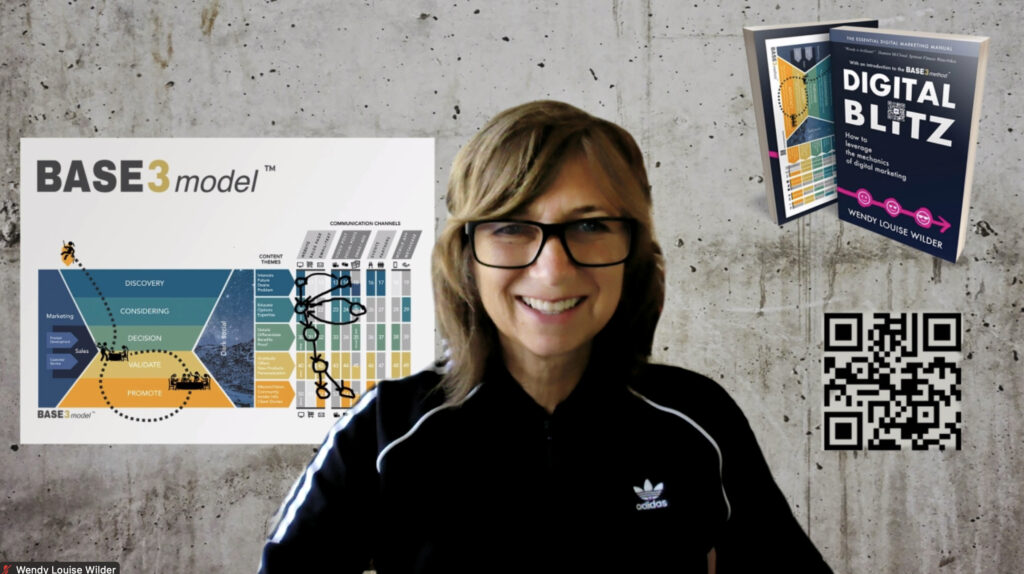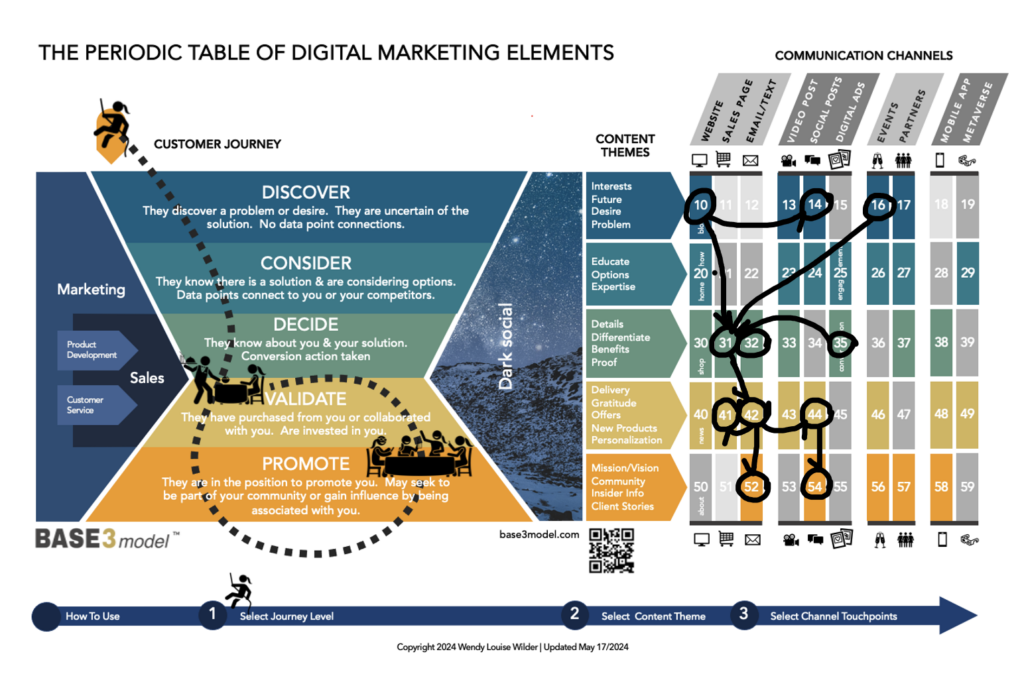BASE3 Marketing Training For Founders, CEOs & Business Managers
You want to set a course for your business

30 Minute Lecture Series
A quick overview of BASE3 will give you the framework you need to guide your marketing team and the trajectory of your business.
Many founders, CEOs and business leaders are frustrated that marketing seems opaque and is constantly changing, which prevents them from setting a predictable course for their business.
The BASE3 model brings logic and structure to marketing initiatives plus a language that enables cross-functional collaboration between leadership, marketing, sales, product and technology teams.
Become the marketing expert your business needs!
Make informed marketing decisions
Attend a 30 minute training designed for founders and business leaders with optional brainstorming session following. Structured so you can quickly learn how to make strategic marketing decisions and direct your marketing team.
Lesson Topics
In this lecture series for Business Managers we will discuss:
- How to segment your audience
- What numbers to watch
- How to prioritize marketing initiatives
Outcome:
You will know how to segment your audience so that you have data to guide your marketing decisions. You will have a framework that facilitates cross-functional collaboration.

Benefits of using the BASE3 Model.
The BASE3 model provides business owners with clear insights into marketing effectiveness by focusing on measurable outcomes and offering a structured approach to understanding the customer journey.
1. A Strategic Framework for Understanding Marketing Impact
Direct Connection to Business Goals
- The BASE3 model starts by aligning marketing activities with business objectives like revenue growth, lead generation, or customer retention.
- Example: If the goal is to increase monthly sales by 20%, marketing campaigns are designed and measured against their contribution to that specific target.
Integrated Approach to Marketing Efforts
- By considering Branding, Audience, Strategy, and Execution holistically, BASE3 ensures that all marketing actions are purposeful and work toward measurable outcomes.
- Example: A unified brand message across email, social media, and paid ads creates a consistent experience, driving customers closer to conversion.
2. Customer Journey Mapping
Understanding the Journey
- BASE3 emphasizes mapping the entire customer journey, from awareness to purchase and post-sale engagement. This allows business owners to see how marketing supports each stage.
- Example Journey Stages:
- Discovering: Potential customers discover the brand through social media, or searches.
- Considering: They visit the website, engage with blog posts, or sign up for the newsletter.
- Deciding: They schedule a consultation or purchase a product or service.
- Validating: They assess your product or service based on their experience with you.
- Promoting: If they feel that they made the right decision in buying from you, they will respond to your follow-up emails, are encouraged to leave reviews, or participate in loyalty programs.
Measurement at Each Journey Level
- Marketing activities are tracked at every touchpoint, providing data on where customers are engaging and where they might drop off.
- Example: If website analytics show high traffic but low conversions, the issue might lie in the “Consideration” phase, prompting improvements in landing page design or messaging.
3. Measuring the Customer Journey with Key Metrics
Discovering Level Metrics
- Tracks how many people are discovering the business.
- Examples: Impressions, website visits, social media reach, video views.
- Insight for Business Owner: How effectively marketing is driving initial interest.
Consideration Level Metrics
- Measures how potential customers interact with content.
- Examples: Time on site, click-through rates (CTR), email open rates, social shares.
- Insight for Business Owner: How compelling the brand’s messaging and content are.
Decision Level Metrics
- Tracks how many leads or prospects turn into paying customers.
- Examples: Conversion rates, cart abandonment rates, lead-to-customer ratios.
- Insight for Business Owner: How well marketing efforts are driving revenue.
Validation Level Metrics
- Measures how many customers remain loyal and return.
- Examples: Customer lifetime value (CLV), repeat purchase rates, Net Promoter Score (NPS).
- Insight for Business Owner: The long-term value of marketing beyond acquisition.
Promotion Level Metrics
- Measures how many customers are giving positive reviews and recommendations.
- Examples: Net Promoter Score (NPS), referral program participation, shares on social media.
- Insight for Business Owner: Learn how much confidence your customers have in your brand. Compare survey NPS results with actual referral data to find opportunities.
4. Data Visualization for Clarity
Dashboards and Reports
- BASE3 incorporates clear reporting tools to visualize marketing performance, providing business owners with at-a-glance insights into campaign success.
- Example: A dashboard showing:
- Audience size vs. reach.
- Customer Decision Progress over time
- Revenue generated from specific campaigns.
- Value: Business owners can quickly identify which marketing activities deliver the best ROI.
5. Attribution Modeling
Pinpointing What Works
- BASE3 enables attribution modeling, which tracks how each marketing touchpoint contributes to a sale or conversion.
- Example: A multi-touch attribution model might reveal that while Facebook ads drive traffic, email marketing is the final push that converts customers.
- Value for Business Owners: A precise understanding of which channels and strategies are worth further investment.
6. Continuous Optimization
Feedback Loop
- BASE3 includes iterative evaluation and improvement, ensuring marketing strategies evolve based on real-world performance.
- Example: If engagement drops in the “Consideration” stage, adjustments like better call-to-actions (CTAs) or retargeting ads can be implemented.
- Value: Marketing remains agile and responsive, minimizing wasted spend.
7. Predictable Growth Through Insights
Scenario Planning
- BASE3 provides predictive insights by analyzing past performance, helping business owners forecast results.
- Example: Knowing that every $1,000 spent on ads generates 50 leads and 10 sales enables strategic budget allocation.
- Value: Owners can confidently plan for growth with data-backed projections.
Example Use Case:
A retail business using BASE3:
- Discovery: Facebook ads generate 10,000 impressions, 2,000 clicks.
- Consideration: 1,500 visitors explore the website, and 500 sign up for a discount code.
- Decision: 200 use the code to make a purchase, with an average order value of $50.
- Validation: 75 respond positively to a customer survey.
- Promoting: 50 customers leave reviews, and 30 sign up for a loyalty program.
Outcome: Reports show a clear ROI of $10,000 in revenue from $2,000 in ad spend, with retention efforts leading to $1,500 in additional future sales.
Why This Matters to Business Owners
- Clarity: BASE3 transforms marketing into a transparent, measurable function.
- Control: Owners see exactly where their investment is going and how it contributes to growth.
- Confidence: Data-backed insights eliminate guesswork, empowering informed decisions about future strategies.
By focusing on the customer journey and measurable outcomes, the BASE3 model bridges the gap between marketing activities and business results, giving business owners unparalleled visibility and confidence in their marketing investments.
How to use the BASE3 chart for documentation and for collaborating with your team.
Documentation

The Communication Channels are numbered so that each can be added to your documentation. There will likely be many steps needed to complete each channel.
Each channel will have a set of production tasks that are needed for completion.
As you begin to use the chart frequently, you will find that you use some of the same channels often in campaigns, and you can create templates for the to-do lists.
By sharing the visual diagram and organizing your campaigns in this way, all team members, whether it be tech, creative, or copywriting or management, they will understand how their work fits into the larger campaign.
Below is a simplified example of to-do items for Channel 10.
